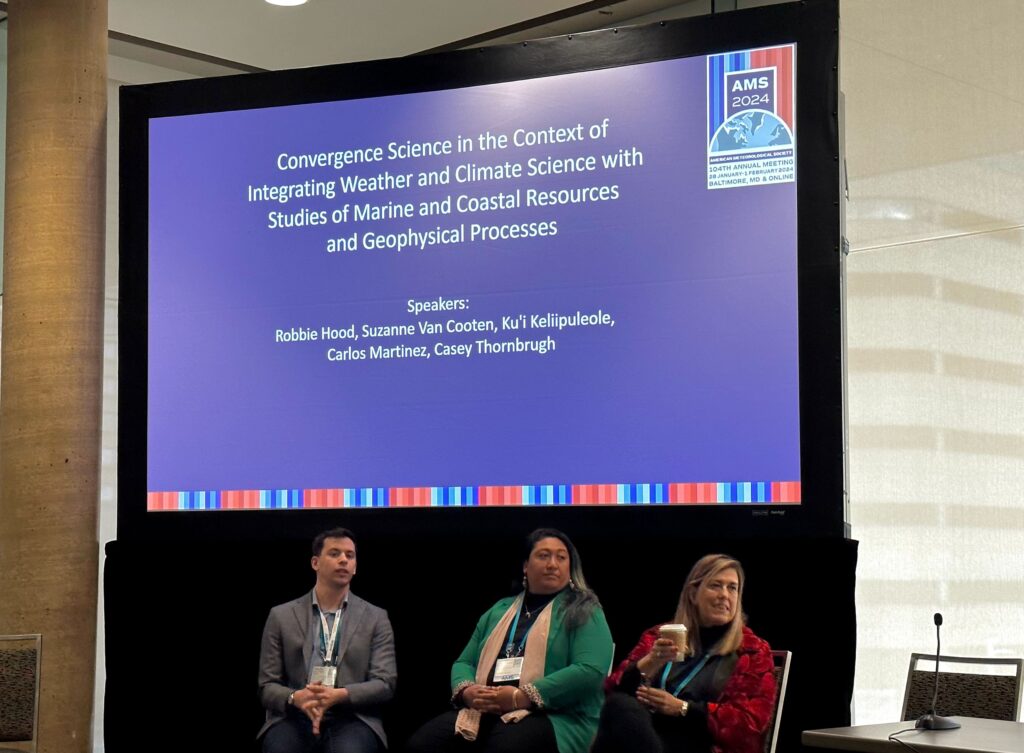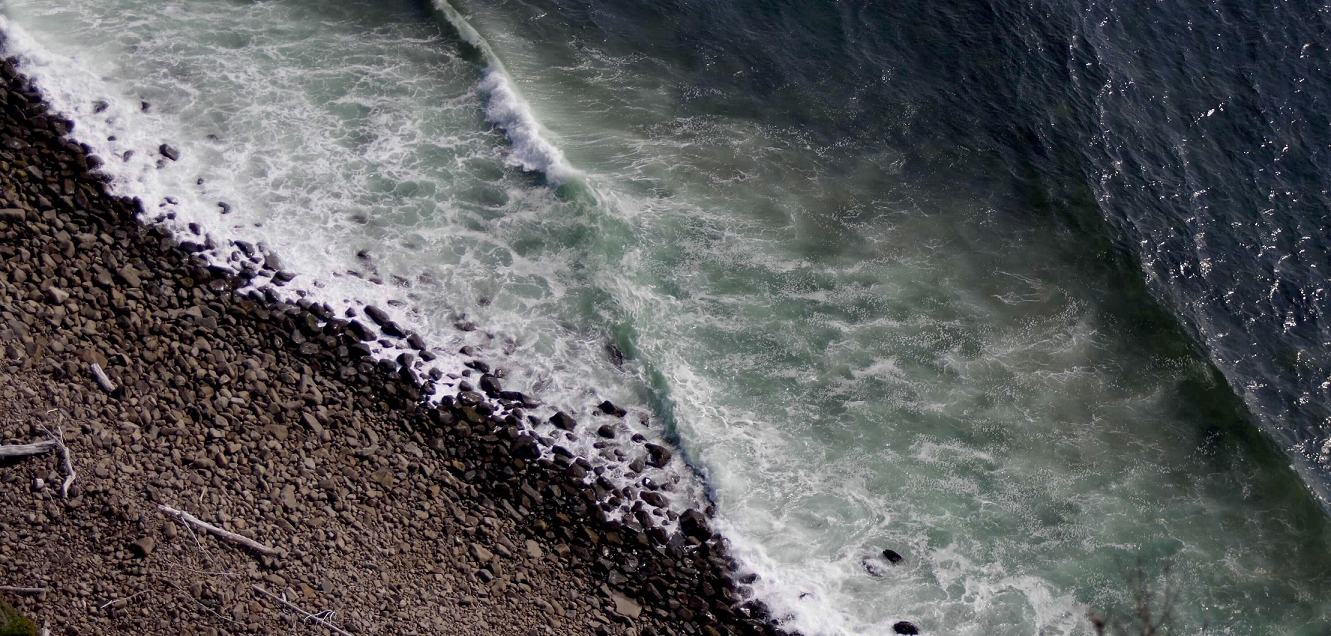AMS 2024 Session Highlight: “Convergence Science in the Context of Integrating Weather and Climate Science with Studies of Marine and Coastal Resources and Geophysical Processes”
By Isabella Herrera, AMS Policy Program
One of the most challenging parts of planning out my week at the AMS Annual Meeting was choosing which symposia and sessions to attend in person, and which to catch on my laptop after leaving Baltimore. Convergence Science: Indigenous Weather, Water and Climate Knowledge Systems, Practices, and Communities was one of the symposia for which I knew I wanted to be “in the room where it happens.” In this case, “the room” was in the Baltimore Convention Center, and unlike many scientific and political discussions throughout the history of the United States, these discussions focused on Indigenous voices and the need for the scientific community to more meaningfully engage with Indigenous science and Native peoples.
The symposium centered on the work of the Rising Voices Center for Indigenous and Earth Sciences (co-administered by NCAR|UCAR and the Livelihoods Knowledge Exchange Network), including the Rising Voices: Changing Coasts (RVCC) research hub. As Lead Investigator Daniel Wildcat said in an opening address for the symposium, RVCC is “catalyzing efforts to bring Indigenous knowledge holders [together] with some of the best university-trained [physical] scientists in the world … to model what convergence science looks like if you include Indigenous wisdom and knowledge.” A short film was played during the morning session to honor the late Dr. Heather Lazrus, Rising Voices co-founder, and her work with Rising Voices.
A panel discussion during the symposium, Convergence Science in the Context of Integrating Weather and Climate Science with Studies of Marine and Coastal Resources and Geophysical Processes, featured a variety of speakers working at the various intersections of weather, water, climate, marine, and Indigenous science. Here are some of the experiences and perspectives shared during this session.
The Convergence of Science and Identity: Being Native in Scientific Spaces
Robbie Hood, a citizen of the Cherokee Nation and atmospheric scientist, started off the session describing her experience having worked for both NASA and NOAA, and mentioned that although she’d been to many AMS Annual Meetings throughout her career, this was her first time being able to represent herself as a Cherokee. Hood emphasized the immense opportunity of convergence science in practice.
“To me, it’s just science,” said Kekuʻiapōiula (Kuʻi) Keliipuleole, a Native Hawaiian and researcher at the University of Hawaiʻi. Native peoples’ knowledge of and connection to their lands is expansive, and deep, and intimate, Keliipuleole explained to us as she introduced herself by naming her mountain (Makanui), her waters (Wai‘ōma‘o and Pūkele), her rain (Lililehua), and her winds (Lililehua and Wai‘ōma‘o). She spoke about being a Native person who studies native organisms in their environment, in Hawaiʻi for Hawaiʻi, and the complexities of merging her identity of being Native and a scientist – of integrating “western” science into her culture.

“From when we are babies, we are learning this method of kilo [a Hawaiian word literally translated as “observations,” but with much deeper meaning in practice] … It’s being able to know the rains and the winds,” she said. “I could tell you that this one tiny section in a road over from my road is constantly flooding … because the government paved a road over an old spring … I see this [particular microbial mat], and I know that comes from groundwater, so I know that that was a spring because I have this kilo, this observational experience.”
Historically, Indigenous scientists have often had to navigate the supposed duality of their identities – of being a scientist and a Native person – and have not been able to include their Indigenous knowledge in their work in the same way they can with the science taught to them through academic institutions. The convergence of western scientific knowledge and Indigenous knowledge is integral to the future of the WWC enterprise.
Suzanne Van Cooten, a citizen of the Chickasaw Nation and Regional Administrator of the USGS South Central Climate Adaptation Center (SC CASC), highlighted the importance of inviting Tribal nations and other groups that have historically been dismissed from climate and water conversations to scientific spaces. She shared her enthusiasm about the first time she was able to forecast for her homelands as a hydrologist.
Respectful Engagement, Not Exploitation
“I think a lot of the Tribes kind of feel like they get talked at more than they get talked with.”
-Daniel Wildcat

The session also featured discussions of how to go about entering Indigenous spaces from the world of western (or, as Van Cooten prefers to say, colonial) science.
Carlos Martinez, a climate scientist, AAAS Science and Technology Policy Fellow, and program coordinator for the National Science Foundation Coastlines and People Program (CoPe), also serves as a board member of the AMS Board of Representation, Accessibility, Inclusion, and Diversity (BRAID). He talked about his experience working with communities on convergence science.
“One of the things I have learned [is] knowing my place in the room … understanding that what I share is through my lived experiences, and not imposing what other people’s experiences are,” Martinez told us.
A humble, listening approach is important for effective engagement, yet non-Indigenous groups often fail to employ this approach when entering Indigenous spaces. “I think a lot of the Tribes kind of feel like they get talked at more than they get talked with,” Daniel Wildcat said. “This is systemic.”
“When immersing in a space with convergence science in mind, [one thing I learned is] actively listening; for example … listening to what the communities are interested in learning, what their needs and concerns are, and then if willing, provide resources or information in communication with one another,” Martinez said. “I always take criticism and feedback as a way for growth, as a way that I can be … a better scientist and a better human being.”
Non-Indigenous scientists should consider their intent versus impact when working with Indigenous communities. Historically, the scientific community has engaged with Indigenous peoples in a way that has been exploitative and continues to perpetuate colonialism, even if the work itself was initially intended to benefit those same communities.
“If you want to work with Indigenous people, then you’ve got to change how you think about what that work requires,” Wildcat told us.
Aspects of science and academia can become obstacles to building trusting relationships – something that is deeply important in working with Indigenous people. Most researchers and policymakers aren’t able to spend the time to establish meaningful and authentic relationships with the tribes they may want to work with, and appropriated dollars can’t be spent on food to host community gatherings.
“[Working with Indigenous people] requires time, it requires meetings where you don’t have an agenda,” Wildcat explained. “You go meet with people, find out what they’re doing, find out what their issues are. . .and then [consider ways you] could assist.”
One of the main challenges Tribes face when it comes to federal funding opportunities, Van Cooten explained, is having the capacity to co-produce applications for funding and then administer the funds. Tribal leaders and program officers are already spread far too thin within their own communities to dedicate any more of their time applying for, let alone managing, large grants. “Yes . . . it’s a huge amount of money, but it will also take a huge amount of management. And so that capacity in the Tribe to manage that, with all the reporting, with everything that’s going to go along with that funding . . . they don’t have that.”
Many of the challenges faced by Tribal Nations are intersectional, and the approaches taken to address them must be, as well. This also rings true for challenges in weather, water, and climate science. Communication is key to both building meaningful relationships and to realizing the full potential of convergence science.
“It’s not much different than trying to put a weather forecaster in the same room with a weather researcher,” Hood told us. “. . .they talk a different language and they’ve got different metrics for what’s important, but if you give them that chance to talk, they’ll work it through. … We just need to open our minds and think about it from both points of view.”
A Change in Culture
These discussions made me consider the profound impacts that this shift in worldview could have on science and society as a whole.
Physical and biological sciences are intrinsically linked, and the need to integrate these two broad disciplines sparked the usage of the term “convergence science” in the first place. Does “western science” continue to limit itself by viewing the Earth and its systems (including biological systems) as entirely separate entities? How is that restriction reinforced by rigid academic and scientific institutions? How can we realize the full potential of convergence science (across various scientific disciplines, and across cultures and communities)?
As Keliipuleole told us, the scientific community “needs more of us to see the world the way that [Native people] see it, and not the way academia raised us to see it.”
There needs to be a culture change. There needs to be capacity building for and within Tribal Nations so that non-Indigenous scientists can engage with Indigenous science, and at universities and Tribal Colleges so students holding this Indigenous knowledge can be a part of the future of the scientific enterprise. There needs to be more of an effort to not just include but to amplify Indigenous voices in spaces like the AMS. The convergence of the western and Indigenous weather, water, and climate sciences must address the ongoing role of colonialism in modern scientific practices, and acknowledge the value of Indigenous science in and of itself.
As Van Cooten said at the start of the discussion:
“[Science] should be inclusive to all communities, not just primarily those that have the loudest voice.”
Header photo credit: Isabella Herrera.
Recordings of all Convergence Science symposium sessions are available now to registered attendees of the AMS 104th Annual Meeting (log in and find each session through the online program). All recordings will be available to the public beginning three months after the meeting.
About the AMS 104th Annual Meeting
The American Meteorological Society’s Annual Meeting brings together thousands of weather, water, and climate scientists, professionals, and students from across the United States and the world. Taking place 28 January to 1 February, 2024 at the Baltimore Convention Center, the AMS 104th Annual Meeting explored the latest scientific and professional advances in areas from renewable energy to space weather, weather and climate extremes, environmental health, and more. In addition, cross-cutting interdisciplinary sessions explored the theme of Living in a Changing Environment, especially the role of the weather, water, and climate enterprise in helping improve society’s response to climate and environmental change. Learn more at annual.ametsoc.org.
